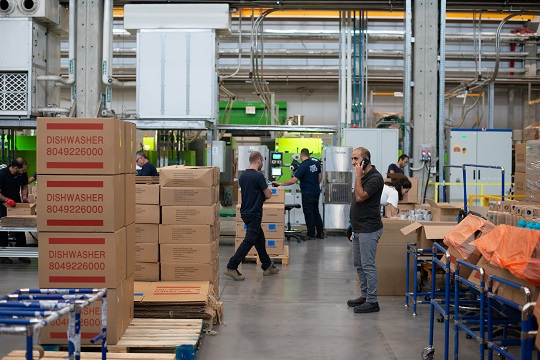Inventory levels are one of the critical aspects of a company’s supply chain management. The inventory level represents the amount of stock a company has on hand and is an essential factor in the company’s cash flow and profitability.
Companies strive to maintain inventory levels that meet their demand while keeping costs low.
However, what if a company’s inventory level is above the industry average, but they are still profitable and have no problems with cash flow or warehouse capacity?
Is this inventory level considered healthy from a supply chain perspective, and what should companies do to achieve the ideal inventory level?
Before we discuss further, make sure you have also joined the scmguide telegram channel so you don’t miss the latest post notifications from this blog and get more insights about other supply chain management topics.
Table of Contents
Is the high inventory level considered healthy from a supply chain perspective?
A high inventory level may seem like a good thing as it ensures the company can fulfill customer orders on time.
However, a high inventory level can also indicate underlying problems in the company’s supply chain.
For instance, a high inventory level can be a result of overproduction, lack of demand forecasting, or poor inventory management practices.
Moreover, high inventory levels increase storage costs, tie up capital, and increase the risk of obsolescence.
On the other hand, a low inventory level may also cause problems.

If a company does not have enough inventory to meet customer demand, it can lead to stockouts, backorders, and lost sales.
Additionally, a low inventory level may lead to increased transportation costs as the company may need to expedite orders to meet customer demand.
Therefore, maintaining an ideal inventory level is essential to a company’s success. But what is the ideal inventory level?
You might also like:
- How Wrong Supply Chain Decisions Can Bring a Business Down
- Stocktaking Faster with Zero Inventory, Here’s How
What is the ideal inventory level?
The ideal inventory level varies depending on the industry, company size, and the type of products or services offered.
However, several factors influence the ideal inventory level. They include demand variability, lead time variability, supply chain uncertainty, and customer service level.
Demand variability refers to how much demand fluctuates over a specific period. If demand variability is high, it is essential to maintain a higher inventory level to ensure customer satisfaction. On the other hand, if demand variability is low, it is possible to maintain a lower inventory level.
Lead time variability refers to how long it takes to replenish inventory from the supplier. If lead time variability is high, it is essential to maintain a higher inventory level to prevent stockouts. On the other hand, if lead time variability is low, it is possible to maintain a lower inventory level.
Supply chain uncertainty refers to the probability of disruptions in the supply chain. If supply chain uncertainty is high, it is essential to maintain a higher inventory level to prevent stockouts. On the other hand, if supply chain uncertainty is low, it is possible to maintain a lower inventory level.

Customer service level refers to the percentage of customer orders that the company can fulfill immediately from stock. If the company has a high customer service level target, it is essential to maintain a higher inventory level to meet the target.
Based on these factors, companies can calculate their ideal inventory level using several methods, such as Economic Order Quantity (EOQ), Materials Requirement Planning (MRP), or Just-In-Time (JIT).
Should companies pursue the industry average inventory level?
The industry average inventory level can be a useful benchmark for companies to compare their inventory levels.
However, it is not always necessary for companies to pursue the industry average inventory level.
The industry average inventory level may be influenced by several factors, such as market conditions, competition, and seasonality. Therefore, companies should focus on their ideal inventory level rather than the industry average.
You might also like:
- 7 Effective Ways to Get 100% Inventory Accuracy
- 6 Steps to Start Managing Your 3PL Performance Effectively
Should companies reduce inventory?
Reducing inventory levels can be a viable option for companies to improve their supply chain performance.
However, it is not always necessary to reduce inventory levels. Instead, companies should focus on optimizing their inventory level to meet their demand while keeping costs low.
How to achieve the ideal inventory level?
Achieving the ideal inventory level requires a well-structured approach to inventory management.
Here are some best practices companies can follow to achieve the ideal inventory level:
- Demand forecasting: Accurately forecasting customer demand is essential to maintaining the ideal inventory level. Companies can use various forecasting techniques such as statistical forecasting, market research, and trend analysis to forecast demand.
- Inventory optimization: Analyzing inventory levels and identifying slow-moving or obsolete inventory can help companies optimize their inventory levels. Companies can use inventory management software to track inventory levels and identify inventory optimization opportunities.
- Supplier management: Collaborating with suppliers can help companies manage their inventory levels better. Companies can work with suppliers to reduce lead times and improve delivery reliability, which can help reduce inventory levels.
- Just-in-time inventory: Adopting a just-in-time (JIT) inventory system can help companies maintain low inventory levels while meeting customer demand. JIT inventory relies on accurate demand forecasting and efficient logistics and can help reduce inventory costs.
- Continuous improvement: Regularly reviewing and analyzing inventory levels and identifying opportunities for improvement can help companies continuously improve their inventory management practices.
Conclusion
In conclusion, maintaining the ideal inventory level is essential to a company’s success.
While the industry average inventory level can be a useful benchmark, companies should focus on their ideal inventory level, which is influenced by demand variability, lead time variability, supply chain uncertainty, and customer service level.
Achieving the ideal inventory level requires a well-structured approach to inventory management, which includes demand forecasting, inventory optimization, supplier management, just-in-time inventory, and continuous improvement.
Hope it useful!
Also share this article with your colleagues so that they can benefit from it too. Join the scmguide telegram channel so you don’t miss the latest updates from this blog. All articles on this blog are free to use for any purpose, including commercial use, without the need for attribution.

 by
by 

